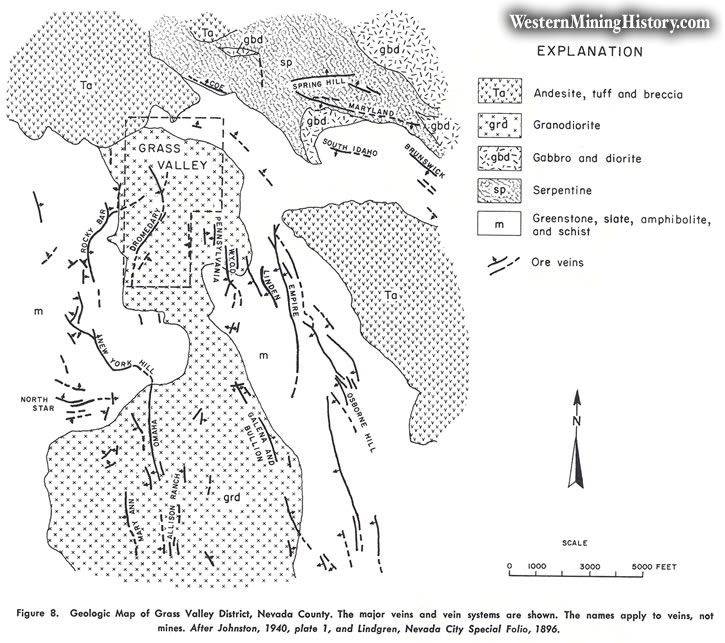Geology
An elongated body of granodiorite is in the central portion of the district (fig. 8). This body is five miles long in a north-south direction and 1/2, to two miles wide. It is intrusive into older metamorphic rocks and itself is cut by various dike rocks. Immediately east and west of the intrusion are dark green stones classified as metadiabase and metadiabase porphyry (so-called "porphyrites"), and continuing to the northeast are amphibolite schist, serpentine, gabbro and diorite, and slate. Just north of the granodiorite and to the southwest are slates, phyllite, quartzite, and schist of the Calaveras Formation (Carboniferous to Permian). A number of intermediate to basic dikes are present also, as well as a few aplite and granite porphyry dikes. Overlying part of the district to the east and to the northwest are Tertiary gravels, in turn largely overlain by andesite.
Ore Deposits
This is the most heavily mineralized and richest gold district in the state with a very large number of productive veins in a relatively small area. The veins fall into two major groups: 1) those of the granodiorite-greenstone area, which have gentle dips, and 2) those of the serpentine-amphibolite area, with steep dips (see fig. 8). The veins of the granodiorite area are either in the granodiorite or in the adjacent greenstone, entering the granodiorite at depth. One group of veins strikes north and dips gently (about 35° on the average) either east or west. This group includes the Empire, Pennsylvania, Osborne Hill, Omaha, W.Y.O.D., and Allison Ranch veins. The other group of veins in the granodiorite strikes west or northwest and dips gently north. The North Star and N ew York Hill veins are included in this group. In the serpentine-amphibolite area the veins strike northwest and dip steeply southwest; a few dip northeast. These occur mostly in the amphibolite near or at the serpentine contact. The Idaho-Maryland, Brunswick, and Union Hill mines are here.
The veins usually range from one to 10 feet in thickness and consist of quartz with some calcite and ankerite. They fill minor thrust faults. Many veins contain several generations of quartz. There are numerous northeast-striking, vertical or steeply-dipping fractures or "crossings" that commonly are boundaries of ore shoots. The ore contains free gold and varying amounts of sulfides, chiefly pyrite. Present in smaller amounts are galena, chalcopyrite, arsenopyrite, sphalerite, and pyrrhotite. Galena is commonly associated with gold.
The ore shoots vary considerably in size and shape, and the distribution of gold within the shoots is erratic. Some have pitch lengths of up to several thousand feet, and the veins have been developed to inclined depths of as much as 11,000 feet. Much specimen ore has been found, but milling ore usually averaged from 0.25 to 0.5 ounce of gold per ton. Coarse-grained scheelite is present in several veins, notablY in the Union Hill and New Brunswick mines.
